Deep Oscillation in Symptomatic Management of Sensory Neuronopathy and Breast Cancer Related Lymphoedema
On 1st September 2020, PhysioPod were contacted by Lucy Grubb, Dr Vodder Lymphoedema Practitioner from The Alison Rostron Treatment Centre with regard to an unexpected and additional benefit when treating a Lymphoedema patient in their care. Whilst implementing Vodder Manual Lymphatic Drainage (MLD) and Deep Oscillation (DOT) in their treatment protocol for Lymphoedema, they also discovered DOT was helping to relieve symptoms of Sensory Neuronopathy (SN).
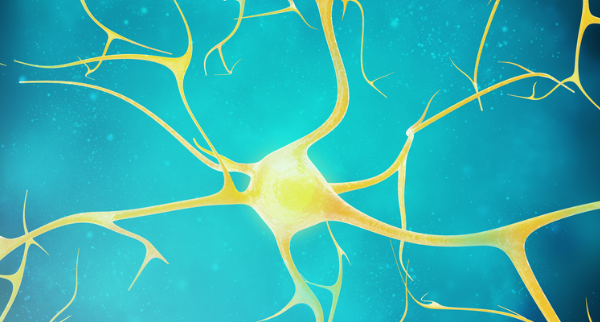
The lady's breast cancer had unusually presented with 'Paraneoplastic Neuropathy". The term paraneoplastic means that the neurological syndrome is not caused by the tumour itself, but by the immunological reactions that the tumour produces, affecting balance, touch, proprioception (knowing where limbs are at any one time). Paraneoplastic Neuropathy' is very rare, the longer it takes to find a cause, the more damage is done.
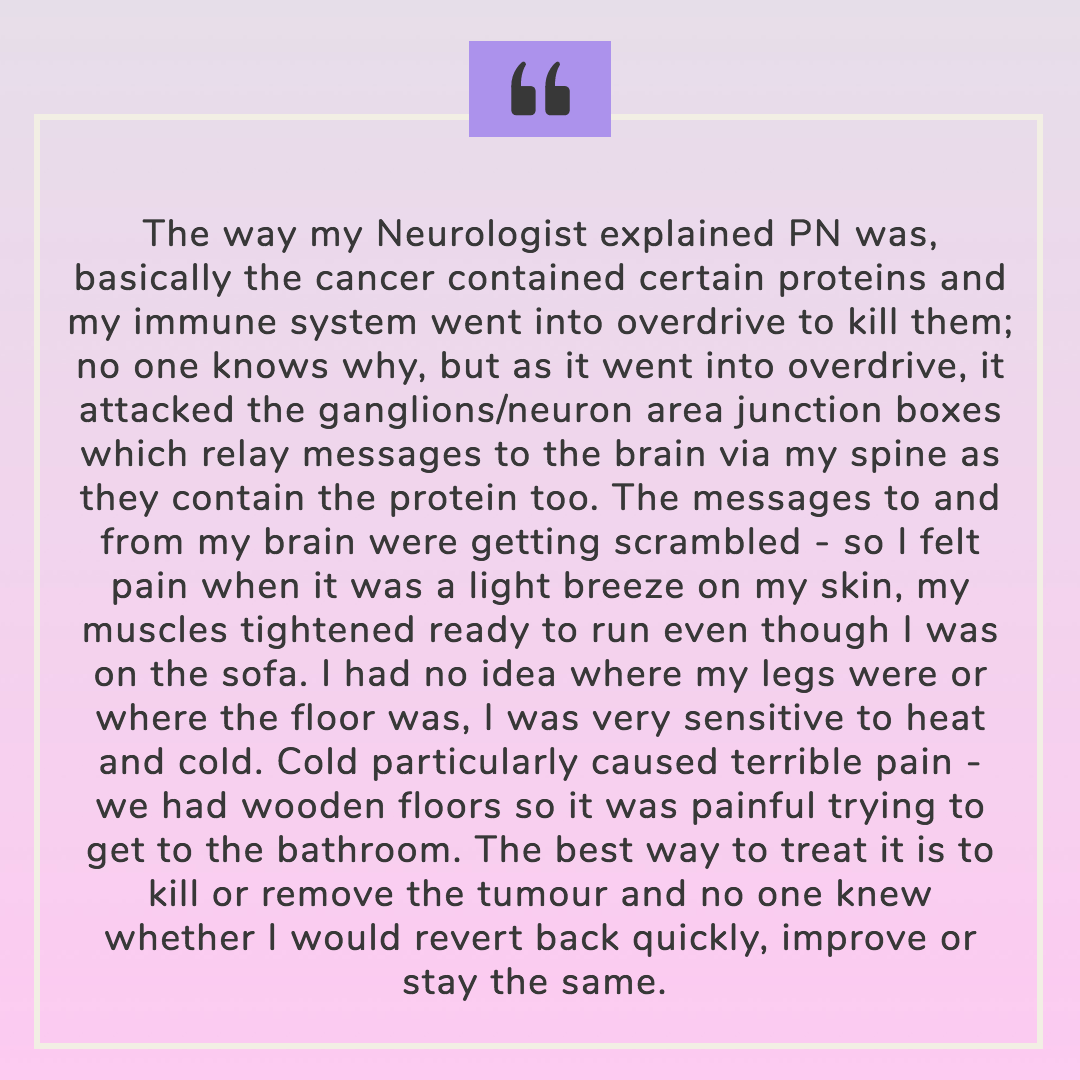
It is referenced that "Paraneoplastic neurological syndromes have been reported in breast cancer as early as 1968"
Exp Hematol Oncol 5, 29 (2015)
and
"Treatment of the underlying malignancy may stabilize or improve the associated paraneoplastic syndrome."
Graus F, Keime-Guibert F, Reñe R, et al (2001)
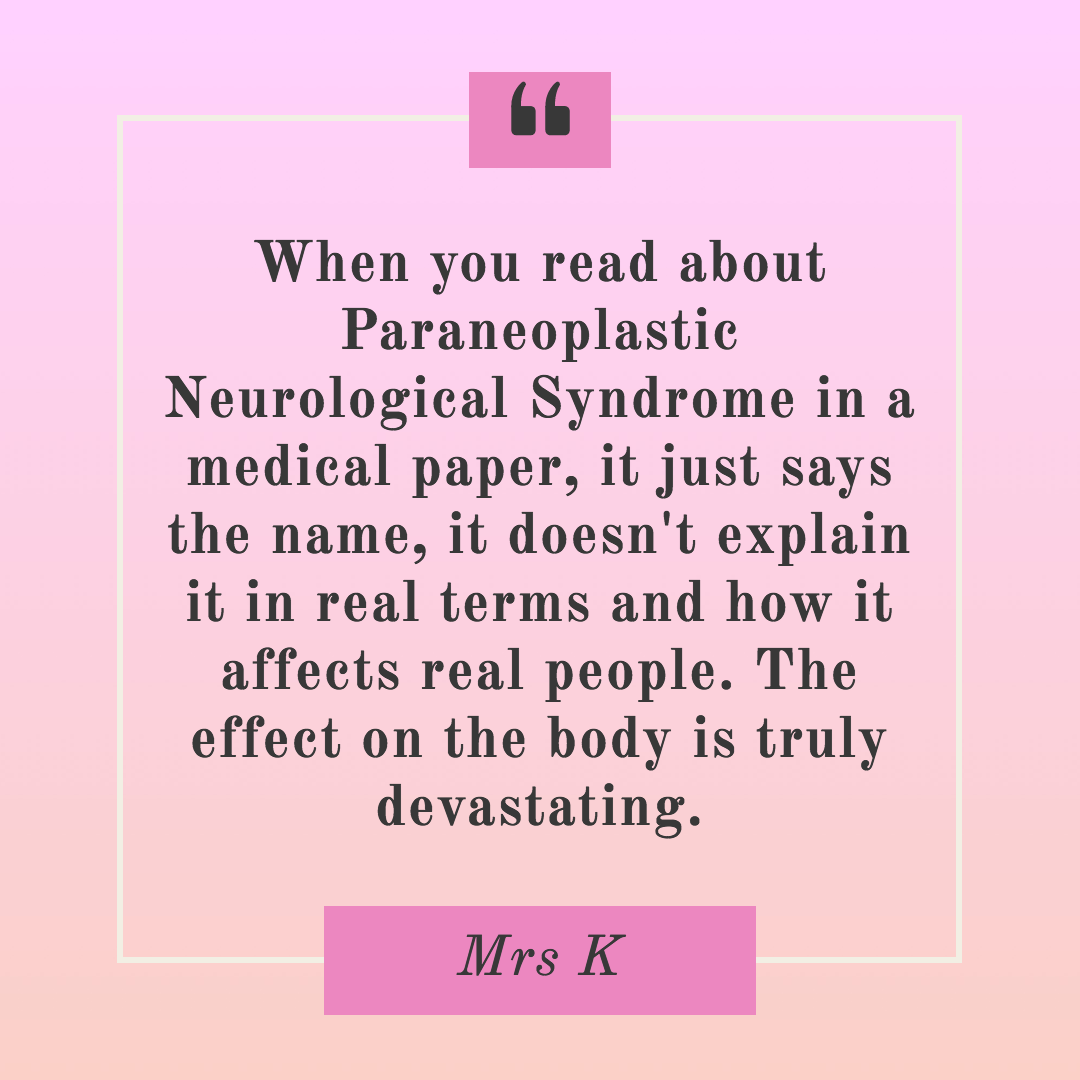
Mrs K has been a driving force in the creation of this article and has expressed an appeal for it to reach as many healthcare professionals as possible and it be made available to the general public. She believes that in showing how the condition has affected her, then readers can understand the sheer enormity of it and if it helps just one other person, then it will be worth it.
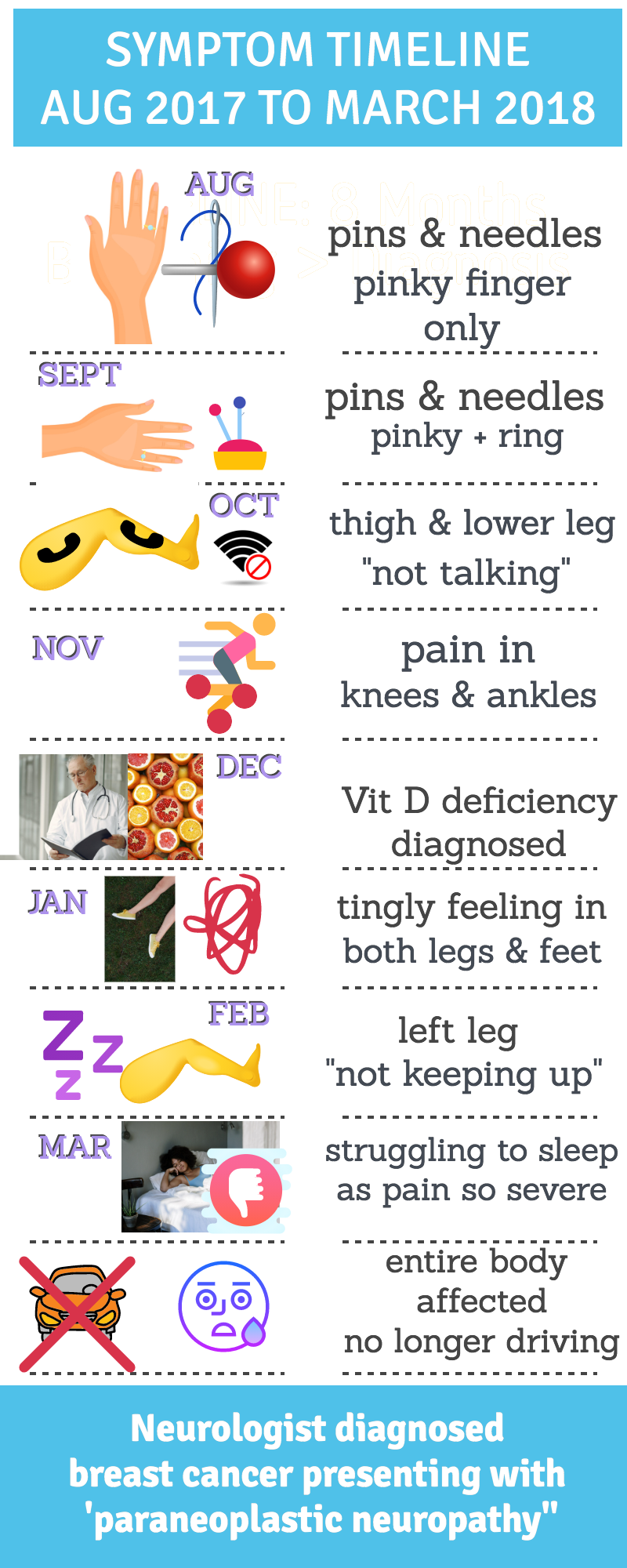
Though first noticeable symptoms were 8 months before diagnosis, rapid deterioration took place in Feb/March 2018:
- By end of February, Mrs K not able to drive: both legs affected (including feet), right arm and five fingers, and thumb on left hand
- Unable to walk without assistance
- Pain so severe, Mrs K wanted to chop her hands and feet off
- Sheets, shoes, socks, sitting on chairs, clothing, wind, rain painful, plus lots of other triggers
Background
Mrs K is 56 years old, with a BMI of 21.9, height 5ft 2” and weight of 54 kg. Mrs K retired from her position as an Administrative Assistant in a school office due to her health problems. Prior to her retirement, Mrs K was fit and active, she enjoyed life to the full and regularly ran with her husband and enjoyed countryside walks. her hobbies were cooking, sewing and she was an avid reader. As an adult she was diagnosed with asthma, this is well-controlled and she has no other co-morbidities. Mrs K has had two routine surgical procedures, a C-section and wisdom tooth extraction.
In March 2018, aged 53, Mrs K was diagnosed with Grade 2, oestrogen positive, invasive ductal cancer, with a preoperative presentation of 'Paraneoplastic Neuropathy'. Mrs K's neurologic symptoms had developed over a period of months, prior to the diagnosis of a tumour by her Neurologist.
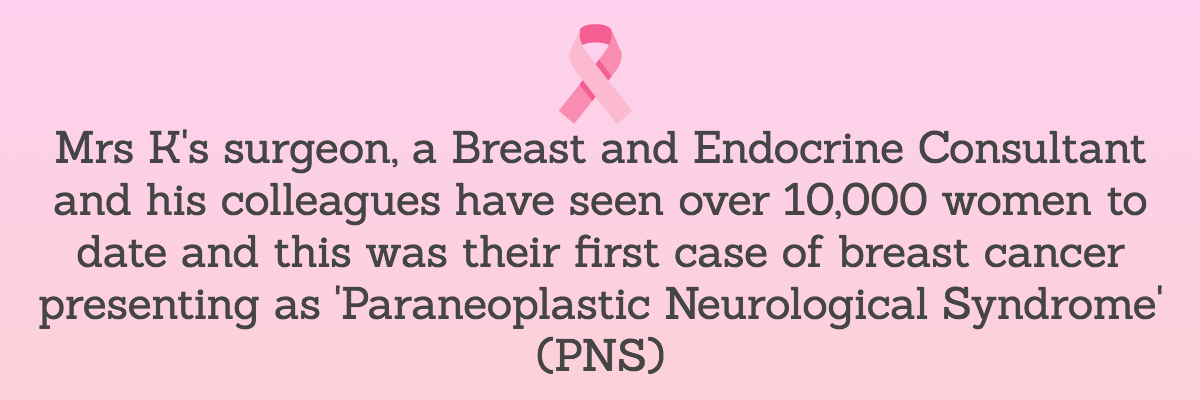
Mrs K cannot drive or go for a walk without assistance because of balance issues. Housework is far from easy to achieve on any basis, in particular hoovering, as backwards and forwards movements are difficult due to loss of balance. Simple tasks of ascending and descending steps safely requires assistance. Mrs K's ability as an avid reader has been seriously impaired as ongoing fatigue and levels of concentration having been affected. Mrs K used to make her own clothes but now scissors get stuck in her grasp and her right foot can fall off the sewing pedal due to loss of sensation and awareness. Cooking is a struggle as she cannot lift heavy pans, so meals have to be adapted to suit her ability.
Fatigue overshadows a huge part of Mrs K's everyday life. She cannot just 'go out for the day' rest times have to be planned and quite often an excursion requires days to recover if she has over done it. The wearing of heels is 'far too dangerous', even small heels. Day to day mobility tasks such as getting down to the floor and back up isn't easy and she cannot get in and out of a bath.
And yet, Mrs K remains positive, even though Sensory Neuronopathy impacts on every single aspect of her life. She strives to be normal again, attempting to laugh and find pleasure in every day. Deep Oscillation, she feels, has given her 'some hope for the future'.
Sensory Neuronopathy Treatment
.png)
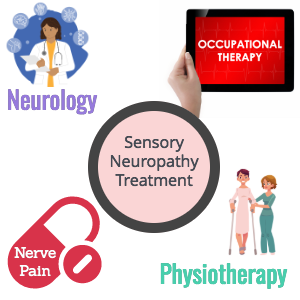
Medication for nerve pain: Gabapentin (three times daily: doses 400mg, 400mg and 600mg) - now reduced to once a day, Amitriptyline 10mg - once daily
Occupational Therapy: Providing aids to assist in the house (trolley, shower seat, toilet support, handrails in shower, perching seat etc) and guidance on desensitisation to reduce the pain of overly sensitive nerves within skin.
Physiotherapy: every month/six weeks, plays a key part in rehabilitation
Neurologist: twice a year for examination of the sensory system, motor system and gait
Breast Cancer Treatment
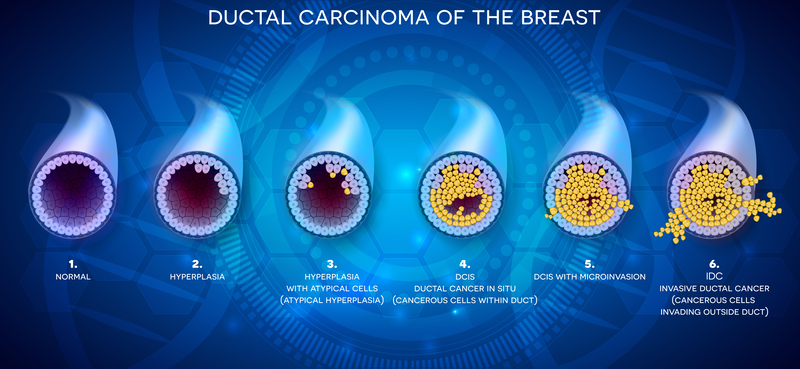
- Positron Emission Tomography scan (PET) prior to chemotherapy to determine spread of cancer
- Primary FEC chemotherapy x 6 sessions
- Lumpectomy to remove 10 mm invasive ductal carcinoma and axillary node clearance of level one and level two lymph nodes (18 nodes removed in total).
- Tamoxifen (20mg per day) prescribed for a period of 10 years,
- Ward Physiotherapist demonstrated exercises to complete following surgery and provided an exercise sheet
- Radiotherapy x 20 sessions
Follow ups: Six-monthly physical checks for lumps and abnormalities, annual mammogram.
Onset of Secondary Lymphoedema
.jpeg)
In October 2019, Mrs K fell, tumbling sideways from her bed and on to her bedside cabinet, causing bruising to her upper arm on the operated left side. The bruising itself reabsorbed naturally, the pain however did not.
In November 2019, Mrs K mentioned the pain to her Physiotherapist who prescribed nerve gliding and stretching exercises, which helped a little to reduce the pain.
However, in March 2020, the arm had started to swell and sleeves fitting the left arm had become tight, Mrs K, normally had 'quite skinny, bony wrists' but noticed the bone on her left wrist was not as prominent as normal and pain remained in her upper arm.
Mrs K's Physiotherapist advised she mention the problems with her arm to her Consultant. At a follow-up appointment with her Consultant, a diagnosis of Stage 1 Secondary Lymphoedema was given and a referral made to the Alison Rostron Treatment Centre in Norwich.
After breast cancer treatment, medication and physiotherapy for SN (though some improvement) symptoms persisted, including fatigue, lack of concentration, severe flare ups of pins and needles in hands and feet (described as an electric shock sensation), a heavy armour feeling in legs, movement/balance/walking problems, a feeling of muscle tightness. Also, following chemotherapy, loss of sense of smell and taste.
.png)
The Alison Rostron Treatment Centre
Practitioner Feedback:
Mrs K was referred to our clinic for treatment of Stage 1 Secondary Lymphoedema by her Consultant. After taking her full medical history and checking contraindications the following protocol was put in place.
Week commencing 16th March 2020 - 4 sessions completed before Lockdown.
Treatment & Method:
- 25 mins x Vodder Manual Lymphatic Drainage (MLD) to non-dominant, left arm and left breast
- 20 mins Deep Oscillation (DOT) to same area, 200 Hz 15 mins, 65 Hz 5 mins, mode 5, intensity 80-100%
Additionally
- Self massage tuition
- Appropriate exercises provided to complement physiotherapy exercises
- Sigvaris compression sleeve arranged - size medium
Results:
Dramatic improvement to left arm in terms of oedema reduction.
Increased flexibility
Increase in energy levels (though initially, Mrs K reported some tiredness post treatment).
Post Lockdown
8th July 2020 through to Mid-Sept 2020: 2 to 3 treatments a week
Treatment and method
As before, plus Deep oscillation treatment to both legs, right hand and wrist.
Results
Mrs K's Lymphoedema is now very well-controlled and managed. She has had a reduction in limb volume of over 300ml from her left affected arm, which now has a lower volume than her right arm (unaffected). Mrs K is very compliant, with both wearing her compression sleeve (now in small size) and doing the relevant exercises and self-massage. There has been a dramatic improvement in muscle sensation and strength, together with more joint flexibility and better muscle tone. Mrs K has also noticed that though nail growth has been stimulated with DOT treatment, where longer nails before were painful to her pins and needles finger tips, they are no longer an issue. Mrs K has experienced more sense of taste periodically, previously lost due to chemotherapy. Walking has improved considerably with more ease and power, particularly immediately after a treatment.
Recommendation/Conclusion
The deep oscillation treatment continued to give Mrs K such strong results for her legs and other related paraneoplastic symptoms that we discussed the option of her purchasing a deep oscillation personal to continue managing it herself, particularly in view of the current COVID-19 situation. After a period of consultation with PhysioPod, they supplied Mrs K with a Deep Oscillation Personal Pro on 9th September 2020. The Pro version, which includes a list of preprogrammed indications and an 'individual' section was deemed the most suitable unit, as frequencies could be altered during treatment and as the symptoms improved. PhysioPod programmed a bespoke treatment protocol to a therapy card as we recommended for use in the device.
.png)
Since receiving her personal unit, Mrs K has seen continued improvements and has reduced her sessions to once a week. We will continue to treat Mrs K to monitor her progress and regularly re-measure her arm for compression. It has been a really rewarding experience to treat Mrs K and her attitude and response have been remarkable. She brings a very positive approach to her treatment plan for a condition that is very rare and often with poor prognosis.
We hope that anyone else being diagnosed with this condition could have the opportunity to benefit from deep oscillation treatment.
About Dr Vodder Manual Lymphatic Drainage (MLD)
.jpeg)
This is a gentle, non-invasive manual technique that has a powerful effect on the body. Research in Australia, Europe and North America has proven its efficacy as a stand-alone treatment and in combination with other therapies. Developed in France in 1932 by Emil and Estrid Vodder MLD has grown to be the most well-known manual technique to assist lymph flow and aid in drainage of tissues.
- The skin is stretched and torqued in a specific manner, based on scientific, physiological principles that have proven to encourage lymph flow. If performed correctly with the correct pressure, direction and speed, this can greatly enhance recovery and facilitate drainage. It also has profound effects on systems in the body.
About Deep Oscillation Electrostatic Lymphatic Drainage:
.jpeg)
Deep Oscillation is a unique, internationally patented treatment method. Its special structure allows the operator to create biologically effective oscillations in the treated tissue using electrostatic attraction and friction. The gentle, pleasant oscillations have a deep-acting effect on all tissue components (skin, connective tissue, muscles, blood and lymph vessels). In contrast to externally applied mechanical forms of vibrational massage (which only act on the surface of the skin), deep oscillation works in the entire tissue layers, permeating a depth of 8 cm (Solangel, 2010), with clinically proven effects in the interstitial spaces of connective tissue structures, breaking down proteins and lymph fluid buildiup in evidence in Lymphoedema. Deep Oscillation is used by many NHS Lymphoedema services and by private Practitioners.
Additional Information From Mrs K
"In December 2018, when I was finishing my radiotherapy I started to get the sense of touch back in my right hand, it still felt awkward and gloved but I made the radiographers cry with my excitement that I could feel the tiny waffle pattern in the blanket that was covering me. My Physiotherapist thinks it is because the last of the cancer cells were destroyed and proper recovery could begin.
I had to stay in a separate room from my husband for about a year and a half, as any touch near my legs would cause me huge pain and he had to build a frame at the bottom of the bed to keep the sheets off my legs. I used to wake up in the night scared because of something in the bed - I didn’t realise it was my other leg. One time, I remember waking up upset because my hand was on my head but I didn’t know that it was mine, I thought someone was there.
I have come a long way but I still have a long way to go. Once chemotherapy started and I had worked out the correct amount of medication, I was generally able to sleep.
I want to get better. I want to run again and I am constantly pushing myself. Sometimes it is possibly dangerous, not knowing where my are, trusting my brain will find the floor. A bus going past can still unsettle me by affecting my balance from the motion, size and noise.
I love to go out in the rain and wind to get my sensory system used to it - I struggled (pre-COVID19) with lots of people moving near me or suddenly changing direction.
There are glimmers of hope, on very good times I can walk next to my husband without sticks. I can balance, but all of this can change within hours, no two days are the same. But I am so much stronger now and I think the Deep Oscillation treatment is going to allow me to improve my walking/agility/balance and strength. I cannot wait to use the personal unit. If it had not been for falling off the bed, I never would have found out about Deep Oscillation helping not just the Lymphoedema but also the Sensory Neuronopathy. Every cloud!
I had returned to the clinic in July and was chatting to Lucy and Alison about my legs and they said ‘shall we try Deep Oscillation on your lower legs and feet to see If it helps?”.
Initially my legs were not that responsive (or so I thought) though I always noticed goose bumps and very quickly, I noticed that the pins and needles I had lessened to a different type of prickly sensation. When I got off the couch, I had more sensation in my feet, which meant I could feel the floor better, which meant my walking was stronger. Each session following, I walked in and out differently
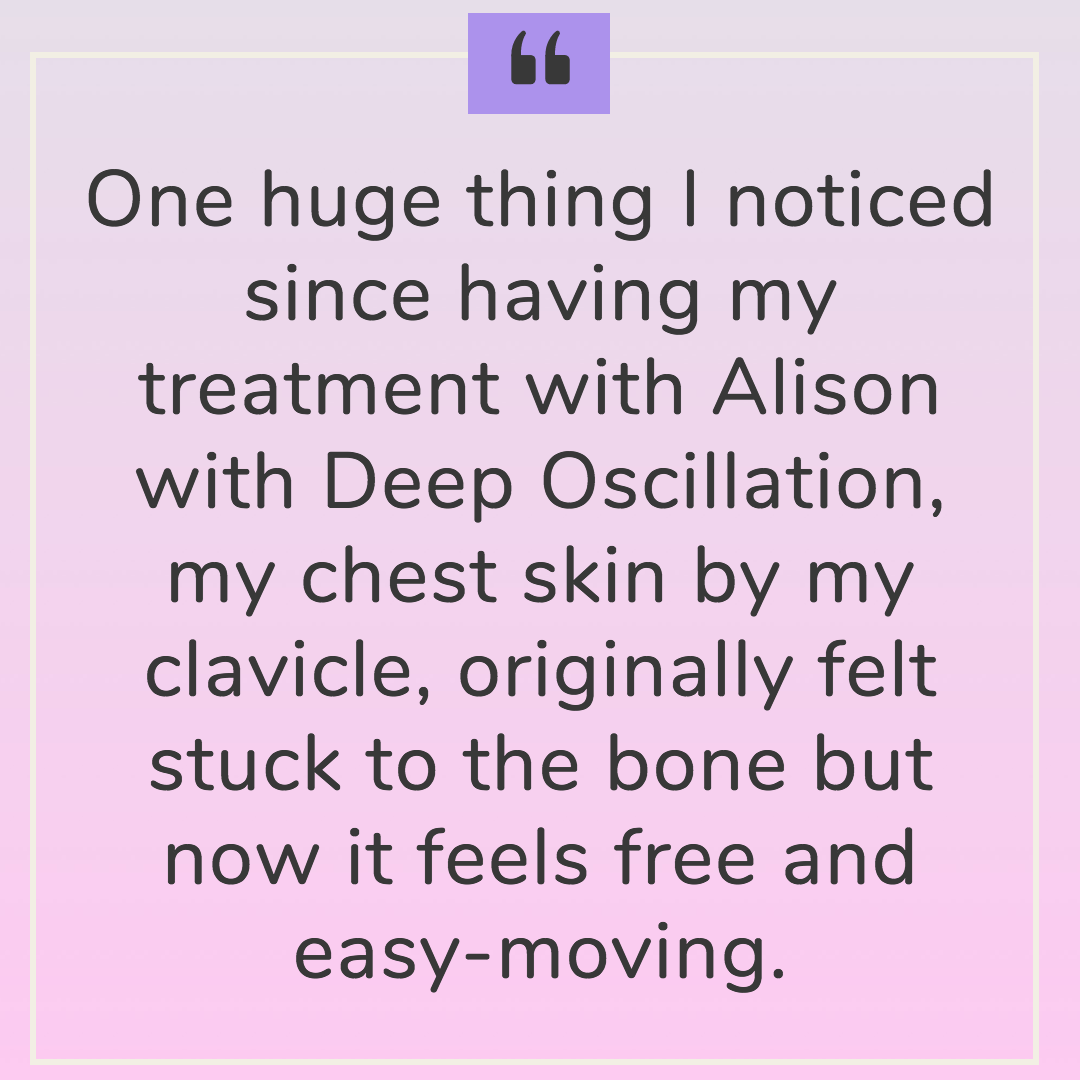
On 11th July 2020, Lucy treated both thighs and my right hand and arm with deep oscillation; the pins and needles actually stopped in my hand after just a few minutes and stayed like that for at least an hour. The hairs on my arm stayed upright for at least the same time, if not longer, the sensitivity in my arm became normal (I had forgotten what it felt like) and sitting in the car on the way home I could feel the seat through my arm like a normal person.
Because the pins and needles get worse generally during the day and my legs or hand/arm gets very tight it is generally uncomfortable (a permanent disruptive sort of pain) all of the time, unless I have a massage or treatment. Because my muscles are tight and uncomfortable this affects the way I walk, so I get sore Achilles and tight calves and thighs and I find it difficult (at its worst) to get in and out of the shower or down steps. Then I become dangerous walking, as I cannot balance as well or my brain does not get the message that the ground is not even, so I can stumble. My toes feel stiff and solid most of the time but after deep oscillation treatment feel softer and more flexible. The severe pins and needles lessen and it feels less painful.
Flare ups happen when the tightness continues and I become tired and fatigued. When it gets like this my feet/hand feel like someone is cutting me or pushing metal skewers into my fingers and toes. The only way out of this is to eventually fall asleep exhausted. My lovely husband helps me every night, as there is sort of a bewitching hour when I get overtired and I need help to walk and sometimes still get in and out of shower and into night clothes.
Fortunately. it’s not all the time but it’s a fine line between fatigue, exercising and rest. I am hoping because I can use the machine several times a day it will relieve the dead, gone to sleep, tight pins and needles feeling and allow me to do my exercises more regularly therefore improving my strength, flexibility and stamina. I feel as if I had plateaued, as I could never get passed the fatigue in my legs etc but I honestly believe this is going to help me move on to the next level.
On a happy note, I find the best in everyday and yes I cry and get down but these are rare days mainly brought on through tiredness and frustration that I can’t move as I would like.
PRE DEEP OSCILLATION SELF TREATMENT
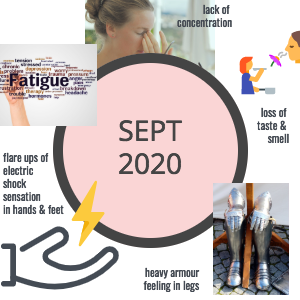
ONE MONTH LATER..
12th October 2020
"Dear Mary and Julie
I did worry about buying the Deep Oscillation Personal Pro, as it was a lot of money and what if it did not help my symptoms in my legs/right hand. I knew it worked, I had seen and felt the benefits in clinic. I should not have worried, as it provided relief from day one.
I received it on 9th September 2020 and charged it on that day - incredible battery life, as I still have not needed to charge it - over a month later.
.png)
Initially, I over treated, it felt so good to have relief from the heavy armour feeling I get in my legs and reduce the severe pins and needles there and in my right hand. So, I would give myself a quick treatment every time they started to feel tight and tingly (four times a day for first few days). It was great to have relieved symptoms but because it stimulates the lymphatics so much it did initially add to a feeling of tiredness.
So, we have now settled on a routine that appears to work. I use it in the morning via the special applicators to treat my Lymphoedema arm (left) and it immediately reduces the full achy feeling, keeping my condition under control. Then I use it on my right hand/arm, legs and feet for the SN.
I also treat my face around the sinus area and above the eyebrow area (trying to stimulate the olfactory bulb) as I lost my sense of smell and taste through chemotherapy in 2018. I occasionally get the odd taste but it does not stay. I rarely smell, three things I can smell are coffee, Cadbury’s chocolate and fish (fish and chips or salmon) but it’s not as you imagine, it’s a horrid, foul smell, as if you should not eat it. It has taken a month but I got an occasional taste we were noticing and I was tasting more frequently so I started to write down smells and taste - initially it would be one smell or taste but over the last two weeks it is like someone has turned those senses on - I can smell from up to 10 items and taste from up to 27 things (in one day - on a good day) and the good news is for the last week it has stayed – it has never done that before.
It is early days and I am hoping it won’t go away again but it is amazing being able to taste things, not everything, but it is brilliant. Sadly, fish and Cadbury’s chocolate still smell horrendous - it’s work in progress!
.png)
My husband treats me in the early evening, about 6pm, using the vinyl gloves method and treats the same areas as I do, with the addition of my back, particularly down my spine.
When I first started using this Mary you asked that I record a score, an “out of ten” on how it feels before treatment and how it feels after treatment. When I received the unit, I was 9/10 before on hands, legs and feet. Horrendous pins and needles and a tightness in my legs as if being squeezed by metal armour.
Generally, I would say treatment reduced my pain/pins and needles to 4/10 on good days. It still fluctuates up and down depending on how fatigued I am, but generally I would say it’s settled to about 5/10 after use and sometimes going as low as 3/10. Plus, it has only returned to 9/10 probably three times since having the machine.
It calms the sensation down most of the time and turns it from severe pins and needles to a scratchy sort of feeling or less intense pins and needles.
One night at midnight I had very bad pins and needles 9/10, I hadn’t been able to get to sleep, and my husband used the pro and it turned them down like in a dial to about 3/10. This meant I could sleep - before I would have had no sleep at all and been in tears with pain. Fatigue makes it worse, so being able to sleep is very important.
I have also noticed that even if it hasn’t turned the pins and needles down straight after a treatment, sometimes it calms an hour and a half later but what’s most noticeable is the movement within my feet and legs. I go from walking like Wallace and Gromit in the wrong trousers, stiff, no flexibility to walking with proper positioning of my feet (heel to toe - feeling the floor properly) and flexibility through my knees meaning I have a more fluid movement. Therefore, better balance.
It is early days, I am nowhere near my old self, but this machine has already improved my symptoms. On very bad fatigue days - it’s still tough, but I believe using this helps to lessen those days enabling me to pick up quicker. Treatment has improved my sleep; therefore, healing has improved. I even used it on a long journey in the car. My legs were getting tight and I could treat myself whilst my husband drove.
I don’t want to get my hopes up but it has already made a big difference to my life. Yes, I am still dangerous in the evening with balance and my mad feet not knowing where they are. I have bad days, but the difference is I can reduce the pain/pins and needles daily (generally) therefore I can build on my fitness and mobility.
It has given some level of control, I do not have to think ‘oh no I’ve got four days till I can get treatment at the clinic’. It’s treatment when I need it in the comfort of my own home, I just use it. If it has helped so much since 9th September and it’s only 13th October today. Think (and hope) what difference it could make in a year.
.png)
Ps my husband has had very stiff finger joints for a good few months (too much windsurfing in cold water). Amazingly, he has noticed that his joint pain has lessened in his fingers and he has better movement. That is just from him treating me using the gloves – you did say he would get a treatment too!
Mrs K
PS - I have just chopped an onion up - nothing new there but it made my eyes stream - that hadn’t happened since before chemo"
References
Fanous, I., Dillon, P. Paraneoplastic neurological complications of breast cancer. Exp Hematol Oncol 5, 29 (2015). https://doi.org/10.1186/s40164-016-0058-x
Graus F, Keime-Guibert F, Reñe R, et al. Anti-Hu-associated paraneoplastic encephalomyelitis: analysis of 200 patients. Brain. 2001;124(Pt 6):1138-1148.
All Deep Oscillation clinical references can be read here
For more information please contact PhysioPod on info@physiopod.co.uk or call the office on 01159 167 685 and ask for Julie Soroczyn.

